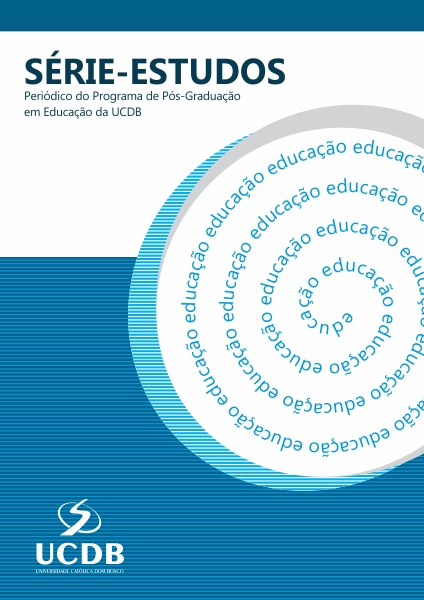O espaço para o aprendizado na infância de 0 a 3 anos: a experiência de instituições de Educação Infantil na Itália
DOI:
https://doi.org/10.20435/serieestudos.v30i68.2000Palabras clave:
educação 0-3, espaço, aprendizagem, formação profissionalResumen
O espaço é um dos fatores determinantes no processo de aprendizado na faixa etária de 0 a 3 anos. A tradição pedagógica italiana tem como referência pedagogos que investigaram o conceito de espaço e sua importância como fator educacional. Um espaço bem estruturado influencia positivamente o desenvolvimento físico, psíquico e relacional das crianças, promovendo um crescimento positivo. Um ambiente educacional acolhedor para crianças de 0 a 3 anos permite experiências sensoriais, motoras, aprendizado, criação, comunicação, pensamento e escuta (Buccolo, 2019). A pesquisa apresentada enfoca a evolução do conceito de espaço na pedagogia da infância de 0 a 3 anos, destacando a necessidade de construir um novo contexto que apoie o processo educacional. O debate atual sobre pedagogia considera fundamental a organização do espaço em ambientes educacionais para crianças, valorizando o contexto como complementar à didática. Emerge da experiência de formação de educadores um método de aprendizado contínuo baseado em observação, reflexão e prática. Essa abordagem busca uma construção colaborativa e inclusiva de espaços educacionais que valoriza a diversidade, garantindo um ambiente educacional colaborativo e acessível para todos. É necessário, continuar investindo na formação de educadores, visando a um planejamento mais consciente e crítico do espaço, para que a "experiência de formação-intervenção" se configure como uma oportunidade de crescimento humano e social.
Citas
AMATORI, G.; MAGGIOLINI S. Pedagogia speciale per la prima infanzia. Politiche, famiglie e servizi. Milão: Pearson, 2021.
BUCCOLO, M. ECEC practice: progettare contesti inclusivi nei servizi 0/6 tra spazi, tempi e routine. Times - Journal of Education, Technology and Social Studies, [S. l.], v. 16, p. 169-182, 2024.
BUCCOLO, M. L’educatore emozionale. Percorsi di alfabetizzazione emotiva per tutta la vita. Milão: FrancoAngeli, 2019.
DEWEY, J. Experience and education. Florença: La nuova Italia, 1958.
DEWEY, J. Democracy and education (Democracia e educação). Florença: La Nuova Italia, 1951.
EDWARDS, C.; GANDINI, L.; FORMAN, G. I cento linguaggi dei bambini. L'approccio di Reggio Emilia all'educazione dell'infanzia. Parma: Edizioni Junior, 2014.
EUROPEAN EDUCATION AND CULTURE EXECUTIVE AGENCY. Key data on early childhood education and care in Europe 2025. Luxembourg: Publications Office of the European Union, 2019.
EUROPEAN UNION. ET2020 Working Group Early Childhood Education and Care: How to recruit, train and motivate weel-qualifieldstaff. Luxembourg: Publications Office of the European Union, 2021.
GALARDINI, A. L’educazione al nido. Pratiche e relazioni. Roma: Carocci, 2020.
MARTÍNEZ-MARTÍ, M. L.; AVIA, M. D.; HERNÁNDEZ-LLOREDA, M. J. Appreciation of beauty training: A web-based intervention. The Journal of Positive Psychology, [S. l.], v. 9, p. 477-481, 2014. https://doi.org/10.1080/17439760.2014.920512. DOI: https://doi.org/10.1080/17439760.2014.920512
MONTESSORI, M. La mente del bambino. Mente assorbente. Milão: Garzanti, 2017.
MONTESSORI, M. Il bambino in famiglia. Milão: Garzanti, 1956.
MONTESSORI, M. La scoperta del bambino. Milão: Garzanti, 1948.
RESTIGLIAN, E. Designing at the crèche. Teorias e práticas educacionais. Roma: Carocci Faber, 2012.
ZHANG, J. W.; PIFF, P. K.; IYER, R.; KOLEVA, S.; KELTNER, D. An occasion for unselfing: beautiful nature leads to prosociality. Journal of Environmental Psychology, [S. l.], v. 37, p. 61-72, 2014. DOI: https://doi.org/10.1016/j.jenvp.2013.11.008
Descargas
Publicado
Cómo citar
Número
Sección
Licencia
Derechos de autor 2025 Maria Buccolo

Esta obra está bajo una licencia internacional Creative Commons Atribución 4.0.
A revista Série-Estudos permite a reprodução total em outro órgão de publicação mediante a autorização por escrito do editor, desde que seja feita citação da fonte (Série-Estudos) e remetido um exemplar da reprodução. A reprodução parcial, superior a 500 palavras, tabelas e figuras deverá ter permissão formal de seus autores.
Direitos Autorais para artigos publicados nesta revista são do autor, com direitos de primeira publicação para a revista. Em virtude de aparecerem nesta revista de acesso público, os artigos são de uso gratuito, com atribuições próprias, em aplicações educacionais e não-comerciais.

